In the heart of Canada’s vibrant academic landscape, a chorus of voices is rising. Canadian universities, renowned for their diversity and excellence, are advocating for a significant change—one that could reshape the educational journey for countless international students. The call is clear: the government must halt international student caps. This plea comes not just from institutions seeking to fill seats, but from a deep-rooted commitment to fostering global connections, promoting cultural exchange, and nurturing academic excellence.
Understanding the Issue:
Canada has long been a beacon for international students, offering world-class education, multicultural experiences, and opportunities for personal and professional growth. However, recent government policies imposing caps on international student enrollment threaten to dim this beacon. These caps, intended to regulate immigration and address domestic concerns, inadvertently hinder the flow of talent and diversity essential to Canada’s educational ecosystem.
The Impact of Caps on Universities:
For Canadian universities, the consequences of these caps are manifold. Beyond mere enrollment numbers, caps restrict the influx of diverse perspectives, innovative ideas, and cross-cultural collaborations that enrich campus life and drive academic progress. They pose challenges to research initiatives, limit opportunities for global networking, and undermine the very essence of higher education as a platform for intellectual exchange and societal advancement.
Moreover, international students contribute significantly to the economic vitality of Canadian communities. They inject billions of dollars into local economies through tuition fees, accommodation, and consumer spending, supporting jobs and businesses across the country. By placing arbitrary limits on their numbers, the government risks stifling this economic engine and depriving communities of valuable resources and opportunities for growth.
The Human Dimension:
Beyond statistics and economic indicators, it’s crucial to recognize the human dimension of this issue. Behind every enrollment figure is a student—a dreamer, an explorer, an aspiring scholar—seeking to broaden their horizons and make a meaningful contribution to society. For many international students, Canada represents more than just a destination for education; it embodies hope, opportunity, and the promise of a better future.
Yet, the imposition of caps introduces uncertainty and barriers to these aspirations. It forces students to navigate complex immigration regulations, endure lengthy processing times, and compete for limited spots in an already competitive landscape. It engenders feelings of exclusion and discouragement, casting doubt on Canada’s commitment to openness and inclusivity.
The Vision for Change:
Amidst these challenges, Canadian universities are united in their vision for change. They envision a future where international students are welcomed with open arms, where barriers to their educational pursuits are dismantled, and where diversity is celebrated as a cornerstone of academic excellence.
Their call to action is twofold: first, to pause and reconsider the imposition of caps on international student enrollment, and second, to collaborate with stakeholders to develop more inclusive and responsive policies that balance immigration objectives with the needs of the academic community.
Proposed Solutions:
To achieve this vision, Canadian universities propose a multi-faceted approach:
- Dialogue and Collaboration: Foster open communication between universities, government agencies, and policymakers to ensure that decisions regarding international student policies are informed by the insights and perspectives of all stakeholders.
- Flexibility and Adaptability: Adopt a flexible and adaptable approach to immigration policies, one that recognizes the dynamic nature of global mobility and the evolving needs of the educational sector.
- Support and Resources: Provide adequate support and resources to universities to accommodate the needs of international students, including assistance with immigration processes, access to essential services, and opportunities for cultural integration.
- Promotion and Outreach: Enhance efforts to promote Canada as a destination of choice for international students, highlighting its academic excellence, cultural diversity, and welcoming environment.
Conclusion:
In the tapestry of Canada’s educational landscape, international students are not just passive participants but active contributors to the rich fabric of diversity, innovation, and excellence. As Canadian universities advocate for a pause on international student caps, they do so not out of self-interest but out of a shared commitment to uphold the values of openness, inclusivity, and academic freedom that lie at the heart of higher education.
In unlocking the doors to opportunity, Canada not only enriches its educational institutions but also strengthens its global standing as a beacon of hope and possibility—a place where dreams take flight and boundaries dissolve in the pursuit of knowledge and understanding.




